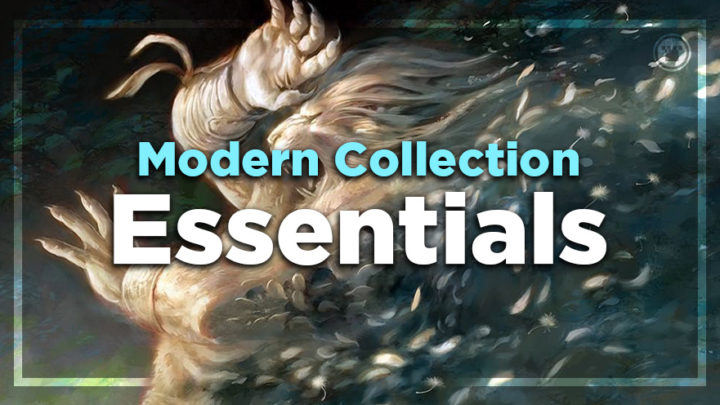Whether you’re new to Modern, returning to Modern, or are an enfranchised player, collection management is important. While Modern often doesn’t transform overnight, there is usually some movement within archetypes in order to adjust to the metagame. Having a well-maintained collection can help you avoid scrambling for cards before a tournament, as well as potentially dodging price spikes.
The first step in building a collection is to make sure you have access to all of the appropriate Modern essentials. Today, we’ll be going over the most important Modern cards to have in your collection.
Lands
Much like a house, every Modern deck needs a strong foundation. Having access to the right lands can greatly increase the number of decks you can play. Let’s take a look at a handful of lands that will go a long way.
Fetch Lands
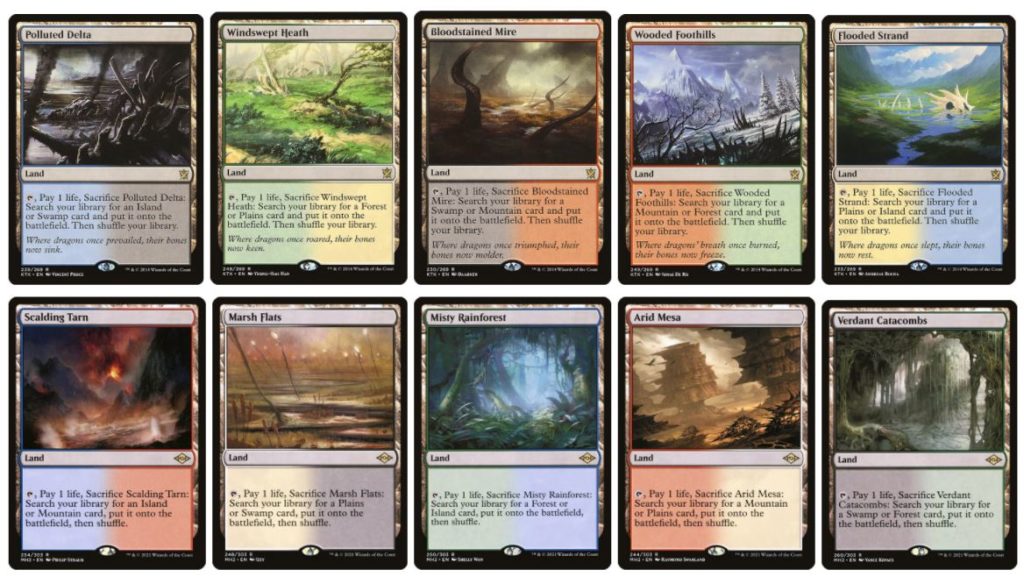
Throughout the course of Modern’s history, you’d be hard pressed to find many top tier decks that didn’t have some number of fetch lands. Decks commonly use 4-12 fetches, depending on how complex their mana base needs to be.
Newer players will sometimes look at fetch lands and ask themselves, “Why would I ever play this? It costs me one life to get a land; I could just play a land, anyway, for free.” The primary answer to that question is color fixing. Fetch lands are the best tool for making sure that you have the correct colors of mana to cast your spells.
In addition to mana fixing, fetch lands have some extra utility with common cards in the format. The damage incurred from fetch lands is less of a downside when you’re playing Death’s Shadow or Scourge of the Skyclaves, which use that cost as an advantage. Fetches also enable triggering landfall twice in the same turn, which is valuable if you’re playing Omnath, Locus of Creation, Ruin Crab, or Hedron Crab. If you’re playing Mishra’s Bauble, you can target yourself and use a fetch land to shuffle away the top card of your library if you don’t want it. Finally, there are some sacrifice synergies with cards like Mayhem Devil, which will get you a little bit of damage whenever you sacrifice a fetch land.
Shock Lands
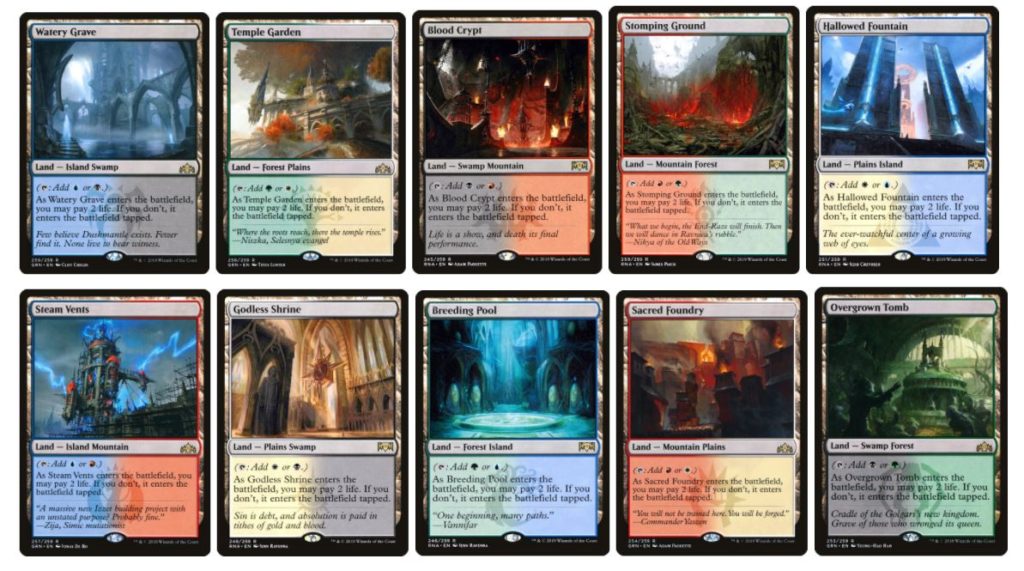
The shock land cycle, originally released in the first Ravnica block, are the premier dual lands in Modern. Because shock lands have land types (Plains, Island, Swamp, Mountain, Forest), they are searchable with fetch lands, forming a powerful mana-fixing duo. Shock lands are the backbone of the Modern mana base because the power level increase of playing multiple colors in a deck is often worth the life loss.
Urza’s Saga
At this point, it may seem like Urza’s Saga can do basically everything — and that isn’t entirely false. This card has many potential applications, but in order to keep things brief, let’s go over the highlights:
- Generates multiple uncounterable creatures that get huge in the right decks
- Tutors for key artifacts such as Colossus Hammer, Shadowspear, Nihil Spellbomb, and Mishra’s Bauble
- Provides enchantment and land card types for delirium
- Provides a powerful late game engine when paired with Wrenn and Six
You’ll find Urza’s Saga most commonly in Hammer Time, Jund Saga, Amulet Titan, Hardened Scales, Affinity, and Eldrazi Tron. Urza’s Saga is one of the most powerful cards in Modern, so as the format continues to evolve, deck builders will be on the lookout for additional homes for it.
Triomes
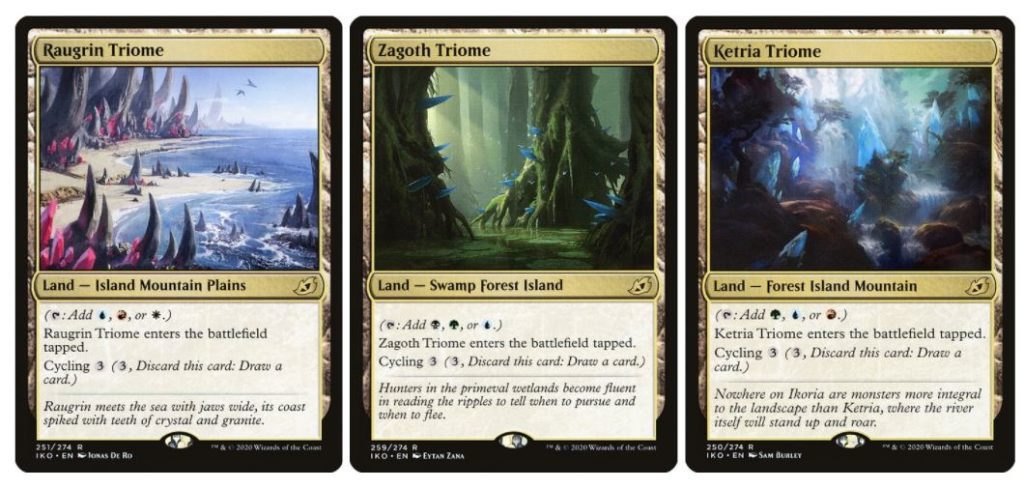
Tapped lands in Modern tend not to see a ton of play, but some cards in the Triome cycle have seen increasing play over time. Ketria, Raugrin, and Zagoth Triome are the most common ones you’ll see, and slower decks with steep mana requirements are the natural home for them. Crashing Footfalls, Elementals, and Bring to Light Scapeshift all have few turn one plays, so they can stand to fetch a Triome on turn one and start setting up their mana. Cycling does come up in longer games, or games where you flood out, adding a bit more value to the Triomes.
Fast lands
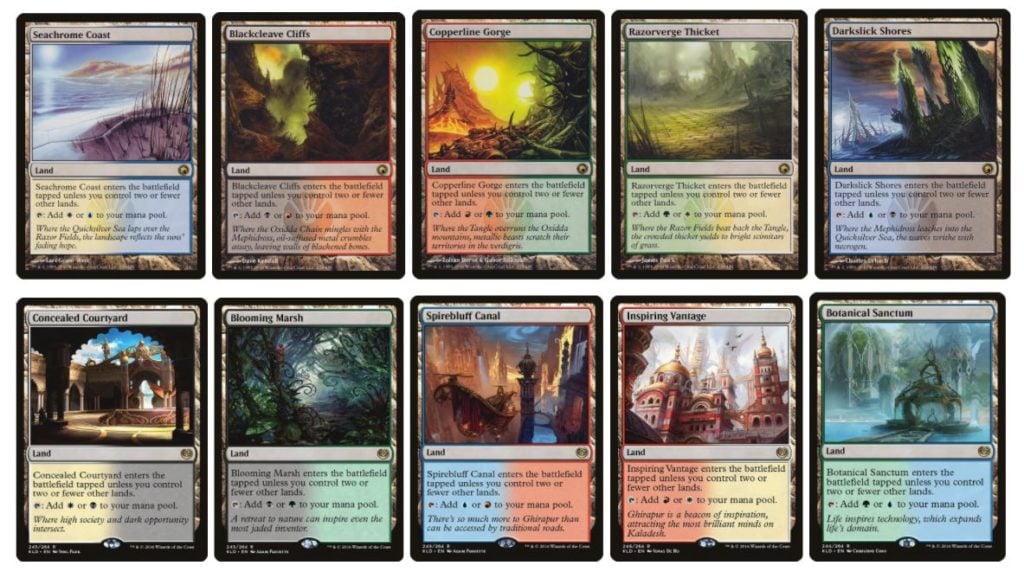
There are two cycles of fast lands: five from Scars of Mirrodin and five from Kaladesh. All these lands have seen reasonable amounts of play at different points in Modern history. Due to the lower curve of Modern currently, this is one of the best times for the fast lands in recent memory, with Razorverge Thicket being the odd one out. While the fast lands aren’t fetchable like the shock lands and Triomes, they can come into play untapped at no cost, provided that you don’t have more than two lands in play. Fast lands tend to be great filler lands to bolster an otherwise fetch land-centric mana base, especially for more aggressive decks.
Cavern of Souls
If Aether Vial is the heart of creature decks, that makes Cavern of Souls…well, the soul. Frequently, Cavern of Souls shows up in tribal decks, such as Humans, Spirits, and Elementals, but that hasn’t stopped Amulet Titan and other decks from playing it to force through specific high-value creatures. Cavern isn’t a card that you’ll find spread through many decks, but in tribal decks, it’s going to be incredibly powerful to shut off opposing counterspells. It can also help fix your mana, especially in the case of Humans, which has demanding color requirements.
Threats
So, with lands out of the way, it’s time to talk about the spells you’ll be casting with them. Threats are the most important part of Modern, and answers aren’t as ubiquitous as they are in other formats. In Modern, there are threats that are powerful enough to play despite being caught by common removal, and threats that are powerful because they dodge common removal. Let’s take a look at a few of Modern’s premier threats.
Lurrus of the Dream-Den
Lurrus of the Dream-Den is one of the best threats in Modern, and one of my personal favorites. Since the release of Ikoria: Lair of Behemoths, Lurrus has seen a consistently high amount of play. The companion mechanic makes it so you always have access to the powerful value-oriented cat.
Lurrus does come with a deck building requirement, which disallows playing permanents with a mana value above two. But given Modern’s low curve, you aren’t giving up much. While Lurrus is traditionally used in aggressively slanted decks, it’s worth noting that it only checks the mana value of permanents. This has allowed Lurrus to see play as a control card alongside Bring to Light and Snapcaster Mage. Underworld Breach combo decks have also employed Lurrus in the past.
And let’s not forget the best thing about Lurrus: you really only need one copy in your collection!
Dragon’s Rage Channeler
For years, Modern tempo decks struggled to find a cornerstone threat; there was no equivalent to Delver of Secrets in Legacy. That is, until Modern Horizons 2 brought us Dragon’s Rage Channeler. Finally, a dependable anchor that tempo strategies can lean on. Evasive, cheap, and hard-hitting, Dragon’s Rage Channeler checks all the boxes to be a premier threat. It even provides card selection whenever you cast a noncreature spell. Dragon’s Rage Channeler looks to be a fixture of Modern for a long time to come.
Ragavan, Nimble Pilferer
Ragavan, Nimble Pilferer and Dragon’s Rage Channeler are a dynamic duo that has given red decks a substantial power boost. While Ragavan may look like a card that aggro decks would love, it plays much more like Deathrite Shaman than Goblin Guide. When mana curves are low across the board, getting a Treasure whenever Ragavan hits the opponent can easily translate into casting an extra spell.
Ragavan allows midrange decks to take an aggressive stance, which has been tough for a number of years. Ragavan can be pricey, but the price is absolutely worth it, in my opinion, as no other card in Modern can do all of the things it does.
Murktide Regent
Gone are the days of Gurmag Angler being the best delve creature in Modern. Rest easy, old friend.
Murktide Regent is a blue Tombstalker, but with the power dial turned up a few notches. It’s the finisher of choice for Modern’s best tempo deck, Izzet Tempo. Thanks to Dark Ritu… uh… Thought Scour, the big Dragon can show up as early as turn two, but will commonly show up around turn four with Counterspell to protect it.
So, what makes Murktide Regent so good? It follows the tempo threat formula: cheap, evasive, and hits HARD. It also dodges Prismatic Ending and Unholy Heat (most of the time), which are two of the best removal spells in Modern.
Stoneforge Mystic
Stoneforge Mystic is the centerpiece of Azorius-based midrange decks called Stoneblade. By cheating a Batterskull or Kaldra Compleat into play, Stoneforge Mystic gives more controlling decks a way to quickly end the game when they need it. It also sees play in more aggressive artifact-based decks like Hammer Time, I’d expect to see Stoneforge around for a while to come.
Crashing Footfalls and Living End
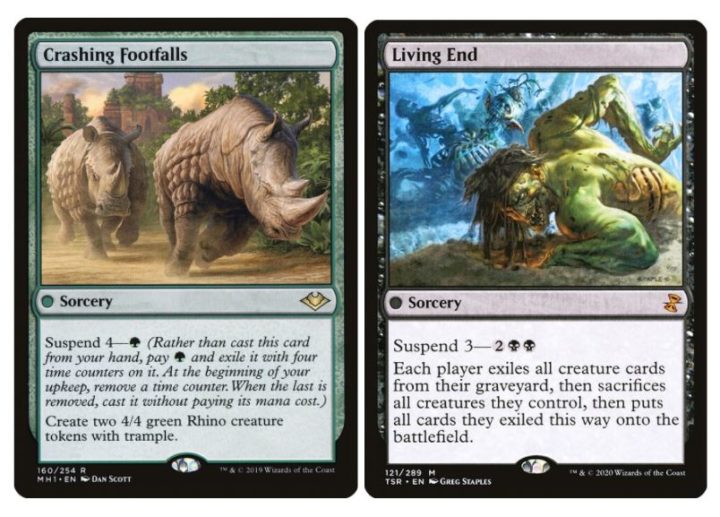
Despite winning the game differently, Crashing Footfalls and Living End serve a similar function. They’re both win conditions of the two major cascade decks, which are named after them. The Crashing Footfalls deck plays a fairer game by interacting with the opponent until it turns the corner with Rhino tokens. Living End is more combo-oriented, but there is a good amount of overlap between the two decks.
Answers
Now that we’ve covered the threats, let’s check out the cards that keep those threats in check. Thankfully, the gap between threats and answers has closed a reasonable amount over the last few years.
Endurance, Fury, Solitude
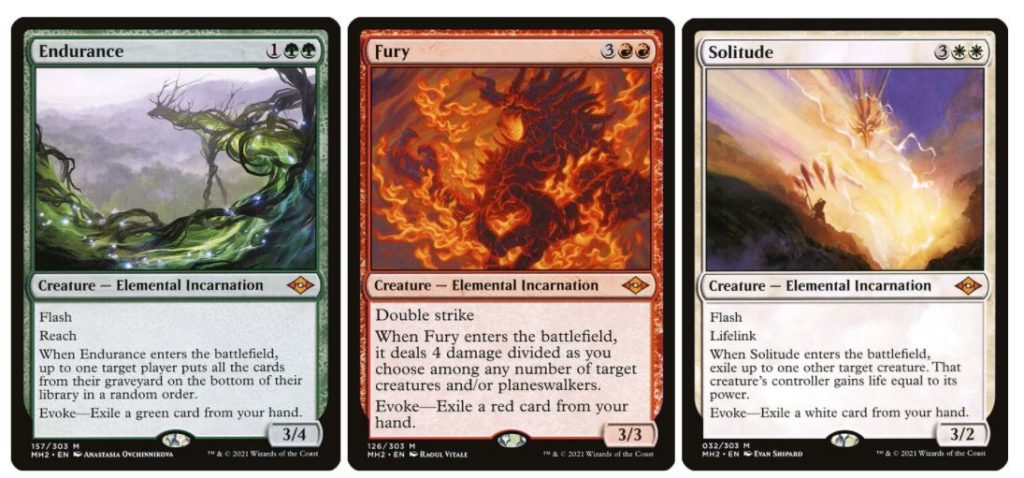
Modern Horizons 2 brought us the cycle of powerful Elementals with the evoke ability. Endurance, Fury, and Solitude are the best of the bunch, though Subtlety and Grief still see some play. In a world where mana efficiency is king, it’s hard to do better than casting a card for free. Sure, evoking all these cards will cost you another card, but you’ll get a lot of extra value in exchange. Plus, these cards all have the upside of being fairly reasonable creatures, should you want to cast them.
Endurance is the most castable of the cycle, which is part of its strength. Graveyard hate that is good enough to main deck has historically been very powerful, and Endurance fits the bill. Endurance is great against Lurrus of the Dream-Den decks, starving them of cards to bring back from the graveyard. A 3/4 reach creature with flash is going to take down Dragon’s Rage Channelers all day long. It even dodges Lightning Bolt and turns off delirium for Unholy Heat. Endurance will surely be a staple of green decks for a while.
Fury doesn’t have flash, but it will often take down multiple small creatures. This is exactly what Elementals and Crashing Footfalls want to do in order to make it to the midgame. If you’ve ever had your Ragavan and Dragon’s Rage Channeler taken down by a Fury, it’s brutal; not only did the Fury cost zero mana, but your opponent ended up even on cards. A 3/3 double striker with a Pyrokinesis enter the battlefield trigger is nothing to scoff at, either, once you get to five mana.
Solitude is maybe the best Flametongue Kavu we’ve ever seen. A 3/2 with flash and lifelink that has Swords to Plowshares attached is incredibly powerful. Elementals, Azorius Control, and Death and Taxes love having access to an early removal spell that isn’t Path to Exile, and getting a body out of it sometimes is a huge bonus.
Unholy Heat and Lightning Bolt
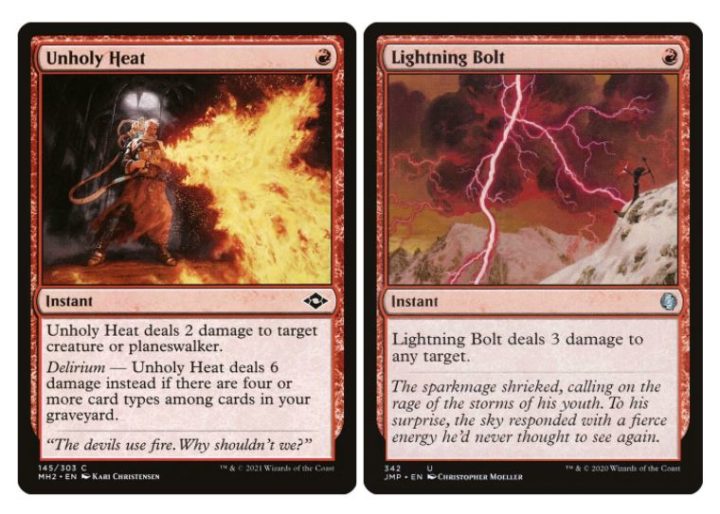
Unholy Heat and Lightning Bolt have teamed up to create a fearsome removal suite for decks interested in getting delirium online. For years, planeswalkers had a noticeable advantage in Modern, because there just wasn’t a profitable way to interact with them. They could often gain loyalty to escape Lightning Bolt range, and cards like Assassin’s Trophy would give the opponent a land after they likely already gained a card from activating their planeswalker. But Unholy Heat has completely changed the game. It answers nearly every creature and planeswalker in Modern for just one mana, provided you have delirium. Given the trajectory of Fatal Push, I’d expect that Unholy Heat won’t be going anywhere but up.
Lightning Bolt is the other half of the equation, but it isn’t anything new. Ragavan, Dragon’s Rage Channeler, and Hammer Time require you to have a certain density of one-mana interaction, so old reliable Lightning Bolt gets the nod. While Lightning Bolt isn’t as good at killing creatures or planeswalkers, it is much better at killing your opponent!
Prismatic Ending
Prismatic Ending all but pushes Path to Exile out of Modern. When there is an abundance of cheap permanents running around, Prismatic Ending looks strong. It also exiles noncreature permanents, which distinguishes it from other removal spells like Path to Exile.
Counterspell
Counterspell was recently added to Modern with the release of Modern Horizons 2. After years of having to dance around which counters you wanted to play, you can just register Counterspell and have a catchall piece of interaction. Goodbye sweating over the splits of Remand, Mana Leak, and Logic Knot; just scribble down four copies of Counterspell and call it a day.
Engineered Explosives
Engineered Explosives oscillates between seeing fringe sideboard play and being one of the best cards in Modern. Right now, it’s on the upswing. Urza’s Saga decks often end up with a lot of zero- or one-mana permanents, and that makes Engineered Explosives attractive against those strategies. It also helps that Lurrus of the Dream-Den can cast Engineered Explosives from the graveyard every turn to really shut down some decks.
Thoughtseize
Finally, we have Thoughtseize — one of my personal favorite cards. Rarely does Thoughtseize fall out of style completely, and it’s always there to pick apart opposing game plans. After all, the best way to answer a problematic card is to never let your opponent cast it in the first place. Plus, you get information about what’s in your opponent’s hand for your troubles. If you like interactive black decks, you’ll want to make sure you have Thoughtseize ready to go.
Utility Cards
Last but not least, let’s round up some of the best utility cards in Modern. These cards don’t quite fit into the sections we’ve covered so far, but they’re still critical in Modern.
Aether Vial
Aether Vial finds its way into just about every creature-dense deck at some point. This powerful artifact lets you cheat on mana, make a creature uncounterable, and put a creature into play at instant speed — all of which are nightmares for control decks. Being able to ambush opposing creatures in combat makes it hard for the opponent to attack profitably into an untapped Aether Vial, shifting favor to the defending player. If scrappy creature decks appeal to you, I’d be sure to snag some Aether Vials.
Nihil Spellbomb And Soul-Guide Lantern
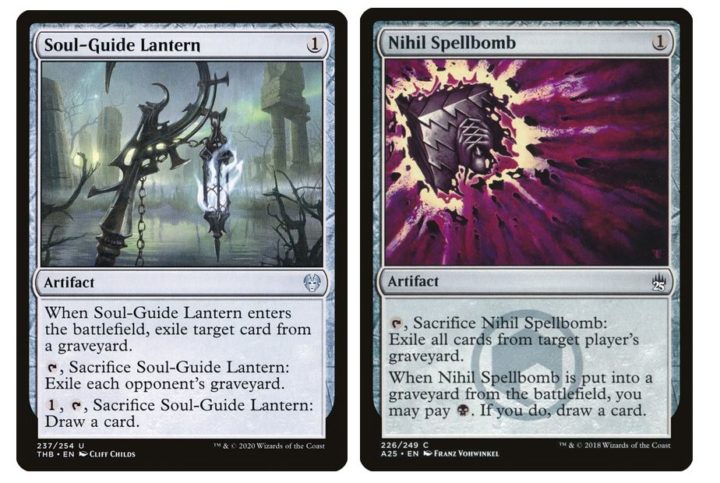
If you take a glance at Modern sideboards, you’re likely to find Nihil Spellbomb or Soul-Guide Lantern. When it comes to choosing your graveyard hate, mana efficiency is often the most important, which is why these two artifacts have such an advantage over the competition.
Mishra’s Bauble
For a while, Mishra’s Bauble was really only played in Death’s Shadow, Mox Opal, and Prowess decks. But now that Lurrus and Dragon’s Rage Channeler are around, Mishra’s Bauble has caught on quite a bit. A zero-mana artifact plays well to trigger Dragon’s Rage Channeler to enable delirium early in the game. Drawing an extra card every turn with Lurrus is the default state for Mishra’s Bauble a lot of the time, until it finds you something better to do.
Void Mirror and Chalice of the Void
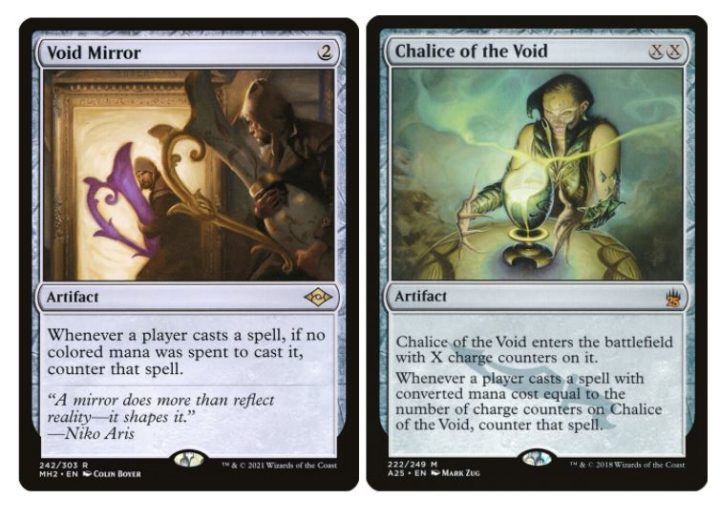
Void Mirror and Chalice of the Void are both primarily used to counter zero-mana spells, specifically Crashing Footfalls and Living End. But they both have some additional utility outside of the cascade match-ups. Void Mirror is an excellent sideboard card against Eldrazi Tron, as they have a difficult time coming up with colored mana. Chalice of the Void is an excellent card to have against Lurrus decks, which are traditionally stuffed with one-mana spells.
Torpor Orb and Dress Down
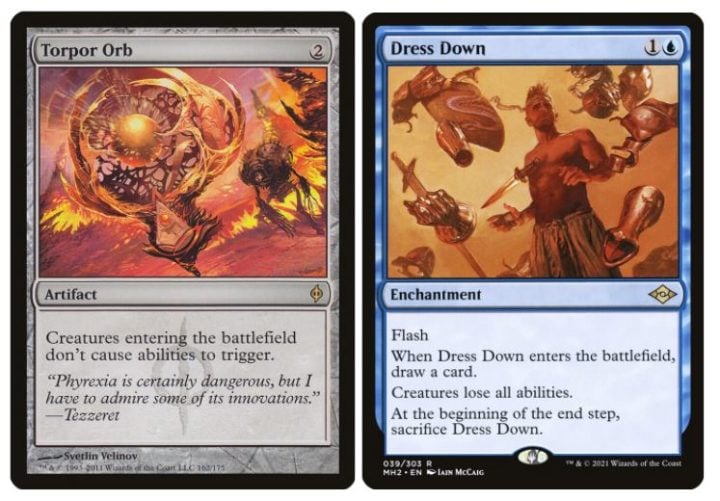
Torpor Orb and Dress Down also function fairly similarly. They both shut down enter the battlefield abilities, which is primarily useful against Elementals. The strength of Torpor Orb is that it sticks around to continue shutting off those abilities. Dress Down, on the other hand, kills all construct tokens, Scourge of the Skyclaves, and Territorial Kavu. Dress Down also shrinks Dragon’s Rage Channeler and Tarmogoyf, making them easy to kill in combat, and removes protection from Auriok Champion and Sanctifier en-Vec. Finally, Dress Down pumps Death’s Shadow into a 13/13, which can lead to some surprise wins.
Expressive Iteration
Expressive Iteration is likely the best cantrip in Modern. It often plays as, “Look at the top three cards of your library, and draw two of them,” which is a ton of value for just two mana. The sorcery type line may seem like a downside, and it is, but Dragon’s Rage Channeler appreciates having good sorceries around for delirium.
There are so many powerful cards worth owning in Modern, and I hope this list has given you a taste of the format. My best piece of advice is to find the deck or style you like, and then pick up all of the core pieces and staples for it. That way, you’ll always be ready to shift when the metagame calls for it.
If you’re newer to Modern, be sure to check out my other content! I’ve written a guide on the best decks in Modern for beginners, and I’ve covered what’s banned in the format and why.
I’d love to hear about your favorite cards in your Modern collection, so be sure to let me know on Twitter at @RappaciousOne!

Michael Rapp is a Modern specialist who favors Thoughtseize decks. Magic sates his desire for competition and constant improvement.

